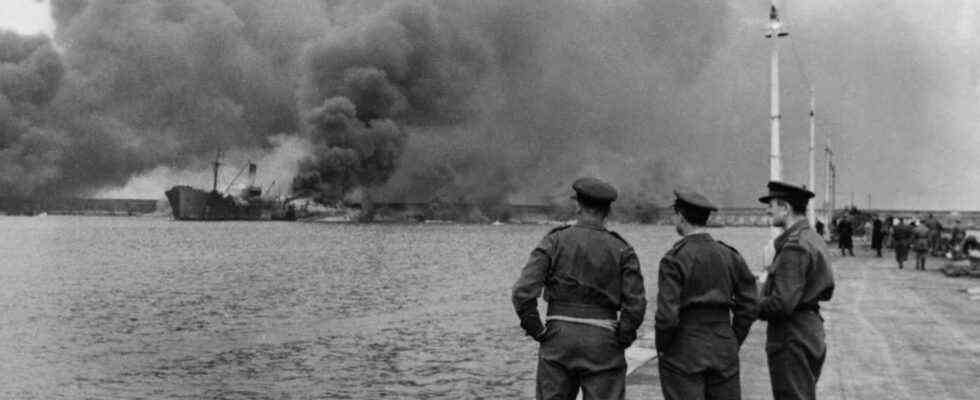In December 1943 the war was lost for the Third Reich. In the east, the major offensive in the Kursk Bogen had failed after the disaster of Stalingrad and the counter-attacks of the Soviets had thrown the Germans far back. In the submarine war, the superiority of the USA, new technical developments and the break in German encryption caused a turning point.
At the same time, the Allied bomber units raided the Reich territory. But the German armed forces were still resisting. In the south, the Allies were able to liberate North Africa and occupy Sicily without much difficulty. But that stopped when they landed on mainland Italy. Field Marshal Kesselring took over the defense, and on his arrival he refused to accept the fatalistic attitude of his staff. He organized a ruthless but effective defense. The Allies’ original plan to advance quickly through the “soft belly of Europe” into the center of the continent failed because of the German defensive lines.
Surprising attack
It was in this context that the German Air Force achieved its greatest success. The former superiority was long lost, but the Luftwaffe was not yet broken. Allied bomber losses over Italy were enormous. But they believed that the Germans were fully occupied with taking down the Allied air offensive. They are no longer capable of larger own actions. But here they were wrong.
On December 2, Air Force pilot Werner Hahn discovered a high concentration of ships in a Me 210 in the port of Bari. The small port was crammed with 30 supply ships. No German attack was expected so far from the front; there was hardly any air defense.
Kesselring and Wolfram von Richthofen, the commander of the 2nd Air Fleet, knew that too. For the attack he was able to quickly pull together 105 medium-sized Ju 88 bombers. The Germans did not have any heavy four-engine bombers such as the B-17 Flying Fortress or the B-24 Liberator. At 7:30 p.m., at the beginning of the night, the attack began. The first machines dropped light bombs over the harbor as a marker for the bombers. That wasn’t necessary. To meet the tremendous need for supplies, the British and Americans work around the clock and as in peacetime. The whole port was fully illuminated. The pilots could see it for 100 kilometers.
Inferno of a city
The attack lasted only 15 minutes and it turned Bari into an inferno. 17 ships were sunk and another eight damaged. Over 1000 soldiers were killed and many civilians as well, as the streets around the harbor were inhabited. The bomb chaos was compounded when a pipeline was hit and the fuel fueled the fires in the port. The explosions from the ammunition ships smashed the window panes eleven kilometers away. The attack was dubbed “Little Pearl Harbor” in the press.
But the worst was to happen that night. The burning fuel reached the “John Harvey”. The ship went up in flames and finally exploded along with its explosive cargo. In addition to ammunition and supplies, the “John Harvey” also had 100 tons of chemical weapons on board. 2000 mustard gas bombs of the type M47A2 were to be brought ashore under strict secrecy. There were no plans to use them, but the high command wanted to be prepared in case the Nazis started a poison gas war.
The basic material of the bombs – liquid sulfur mustard – got into the harbor water during the explosion and mixed with splashes and droplet clouds. The sailors who swam in the water were covered with an oily mixture in which sulfur mustard settled.
Nobody in Bari knew about the dangerous cargo. The injured were treated incorrectly. The medics believed they were just going to be in shock. They were given morphine and sat in their oil-soaked uniforms. So they were downright marinated in the sulfur mustard.
At a loss for treatment
The doctors and nurses were at a loss when they noticed unusual symptoms. Thirst, fever and lethargy, huge blisters on the skin, eyes swollen shut. Many apparently healthy survivors suddenly showed symptoms of gas poisoning. Now the high command was alerted. It was thought that the Germans had dropped gas. Five days later, Lieutenant Colonel Francis Alexander, an expert in chemical warfare, arrived in Bari. It was immediately clear to him that the injured were exposed to mustard gas. But nobody was allowed to know anything about the cargo of the “John Harvey”. It was only when divers found the remains of their own mustard gas bombs in the harbor that it was clear what had happened.
But US General Dwight D. Eisenhower and British Prime Minister Winston Churchill wanted to hide the truth about the poison gas shipment, fearing it could serve as an excuse for Germany to start an all-out gas war. To cover up the incident, the medical reports were tweaked. There was no mention of mustard gas, “hostile burns” were replaced. The 600 survivors were left alone with their long-term consequences.
Birth of chemotherapy
But Alexander’s research had an unexpected result. His “Final Report of the Bari Mustard Casualties” was locked away as secret, but Colonel Cornelius P. Rhoads, chief of the Chemical Warfare Service (CWS), was able to take a look. Rhoads was a cancer specialist. He saw that the sulfur mustard had killed white blood cells. Rhoads took with him a belief that the harmful substance could be used to cure cancer. The idea of chemotherapy was born, and in 1945 Rhoads developed the first anti-cancer drug.
Sources: History, Jamie Mc Trusty

